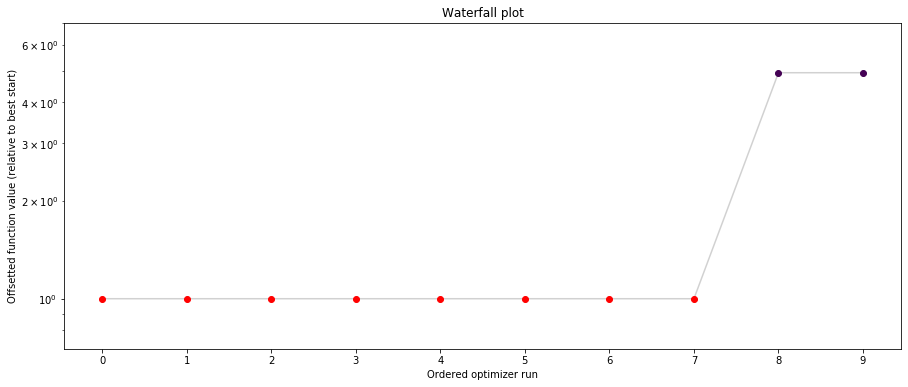Definition of Priors:¶
In this notebook we demonstrate how to include prior knowledge into a parameter inference problem, in particular how to define (log-)priors for parameters. If you want to maximize your posterior distribution, you need to define
A (negative log-)likelihood
A (log-)prior
The posterior is then built as an AggregatedObjective. If you import a problem via PEtab and the priors are contained in the parameter table, the definition of priors is done automatically.
CAUTION: The user needs to specify the negative log-likelihood, while the log-prior is internally mulitplied by -1.
[1]:
import numpy as np
import scipy as sp
import pypesto
Example: Rosenbrock Banana¶
We will use the Rosenbrock Banana
as an example. Here we interpret the first term as the negative log-likelihood and the second term as Gaussian log-prior with mean \(1\) and standard deviation \(1/\sqrt{2}\).
Note that the second term is only equivalent to the negative log-distribution of a Gaussian up to a constant.
Define the negative log-likelihood¶
[2]:
n_x = 5
def rosenbrock_part_1(x):
"""
Calculate obj. fct + gradient of the "likelihood" part.
"""
obj = sum(100.0*(x[1:] - x[:-1]**2.0)**2.0)
grad = np.zeros_like(x)
grad[:-1] += -400 * (x[1:] - x[:-1]**2.0) * x[:-1]
grad[1:] += 200 * (x[1:] - x[:-1]**2.0)
return (obj, grad)
neg_log_likelihood = pypesto.Objective(fun=rosenbrock_part_1, grad=True)
Define the log-prior¶
A prior on an individual paramater is defined in a prior_dict, which contains the following key-value pairs:
index: Index of the parameterdensity_fun: (Log-)posterior. (Scalar function!)density_dx: d/dx (Log-)posterior (optional)density_ddx: d2/dx2 (Log-)posterior (optional)
A prior_dict can be either obtained by get_parameter_prior_dict for several common priors, or defined by the user.
[3]:
from pypesto.objective.priors import get_parameter_prior_dict
# create a list of prior dicts...
prior_list = []
mean = 1
std_dev = 1 / np.sqrt(2)
for i in range(n_x-1):
prior_list.append(get_parameter_prior_dict(i, 'normal', [mean, std_dev]))
# create the prior
neg_log_prior = pypesto.objective.NegLogParameterPriors(prior_list)
Define the negative log-posterior and the problem¶
The negative log-posterior is defined as an AggregatedObjective. Since optimization/visualization is not the main focus of this notebook, the reader is referred to other examples for a more in-depth presentation of these.
[4]:
neg_log_posterior = pypesto.objective.AggregatedObjective([neg_log_likelihood, neg_log_prior])
lb = -5 * np.ones((n_x, 1))
ub = 5 * np.ones((n_x, 1))
problem = pypesto.Problem(objective=neg_log_posterior,
lb=lb,
ub=ub)
Optimize¶
[5]:
import pypesto.optimize as optimize
result = optimize.minimize(problem=problem, n_starts=10)
Some basic visualizations¶
[6]:
import pypesto.visualize as visualize
visualize.waterfall(result, size=(15,6))
# parallel coordinates plot for best 5 fits
visualize.parameters(result, start_indices=5)
[6]:
<matplotlib.axes._subplots.AxesSubplot at 0x12faa1908>


[ ]: